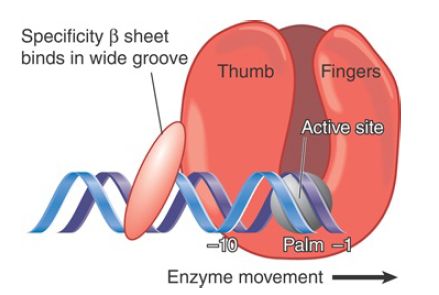


 النبات
النبات
 الحيوان
الحيوان
 الأحياء المجهرية
الأحياء المجهرية
 علم الأمراض
علم الأمراض
 التقانة الإحيائية
التقانة الإحيائية
 التقنية الحيوية المكروبية
التقنية الحيوية المكروبية
 التقنية الحياتية النانوية
التقنية الحياتية النانوية
 علم الأجنة
علم الأجنة
 الأحياء الجزيئي
الأحياء الجزيئي
 علم وظائف الأعضاء
علم وظائف الأعضاء
 الغدد
الغدد
 المضادات الحيوية
المضادات الحيوية|
Read More
Date: 11-11-2020
Date: 8-12-2015
Date: 17-4-2021
|
Phage T7 RNA Polymerase Is a Useful Model System
KEY CONCEPTS
- The T7 family of RNA polymerases are single polypeptides with the ability to recognize phage promoters and carry out many of the activities of the multisubunit RNA polymerases.
- Crystal structures of T7 family RNA polymerases with DNA identify the DNA-binding region and the active site and suggest models for promoter escape.
Certain bacteriophages (e.g., T3, T7, N4) make their own RNA polymerases, consisting of single polypeptide chains. These RNA polymerases recognize just a few promoters on the phage DNA, but they carry out many of the activities of the multisubunit RNA polymerases. Thus, they provide model systems for the study of specific transcription functions.
For example, the T7 RNA polymerase is a single polypeptide chain of less than 100 kD. It synthesizes RNA at a rate of about 300 nucleotides per second at 37°C, a rate that is much faster than that of the multisubunit RNA polymerase of its bacterial host and faster than the ribosomes that translate its mRNAs. Thus, T7-directed transcription would be subject to transcriptional polarity if it were not for the fact that transcription by T7 RNA polymerase occurs only later in infection, when rho expression is limited.
The T7 RNA polymerase is homologous to DNA and RNA polymerases in that the catalytic cores of all three enzymes have similar structures. The DNA lies in a “palm” surrounded by “fingers” and a “thumb,” and the enzymes use an identical catalytic mechanism. Several crystal structures of the T7 and N4 RNA polymerases are now available.
T7 RNA polymerase recognizes its target sequence in DNA by binding to bases in the major groove, as shown in FIGURE 1, using a specificity loop formed by a β ribbon. This feature is unique to the single-subunit RNA polymerases (it is not found in DNA polymerases). Like the multisubunit RNA polymerases, the promoter consists of specific bases in DNA upstream of the transcription start site, although T7 promoters consist of fewer bases than promoters typically recognized by multisubunit RNA polymerases.

FIGURE 1. T7 RNA polymerase has a specificity loop that binds positions −7 to −11 of the promoter while positions −1 to −4 enter the active site.
The transition from the promoter initiation complex to the elongation complex is accomplished by two major conformational changes in the enzyme. First, as with the multisubunit RNA polymerases, the template is “scrunched” in the active site, and the enzyme remains bound to the promoter as the polymerase undergoes abortive synthesis, producing short transcripts from 2 to 12 nucleotides in length. The promoter-binding domain would present an obstacle to abortive product formation if it were not for the fact that it is moved out of the way by a rotation of approximately 45°, allowing the polymerase to maintain promoter contacts during synthesis of the initial RNA transcript. This is analogous to the displacement of the sigma factor domain 3–domain 4 linker from the RNA exit channel during the initial stages of RNA synthesis in the multisubunit bacterial RNA polymerase. The RNA emerges to the surface of the enzyme when 12 to 14 nucleotides have been synthesized. An even larger conformational change occurs next, in which a subdomain called region H moves more than 70 Å from its location in the initiation complex. This massive structural reorganization of the Nterminal domain upon formation of the elongation complex creates a tunnel through which the RNA transcript can exit, as well as a binding site for the single-stranded nontemplate DNA of the transcription bubble.



|
|
|
|
التوتر والسرطان.. علماء يحذرون من "صلة خطيرة"
|
|
|
|
|
|
|
مرآة السيارة: مدى دقة عكسها للصورة الصحيحة
|
|
|
|
|
|
|
نحو شراكة وطنية متكاملة.. الأمين العام للعتبة الحسينية يبحث مع وكيل وزارة الخارجية آفاق التعاون المؤسسي
|
|
|